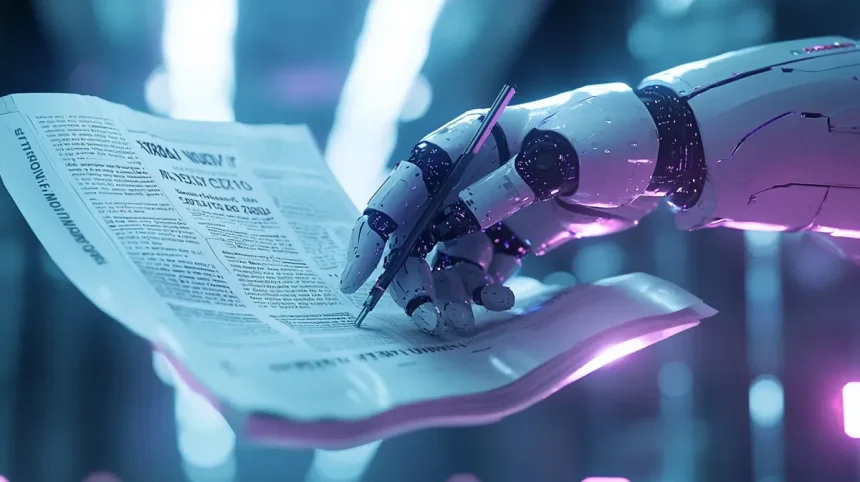AI and humans are entering a new era of collaboration, especially in fields like journalism. Artificial intelligence enhances speed, accuracy, and data analysis, while human insight ensures context, ethics, and emotional depth.
This partnership is revolutionizing newsrooms by automating routine tasks and amplifying creativity. Journalists now use AI tools to investigate, write, and verify content faster than ever. As this synergy grows, it promises a more dynamic and responsive media landscape.
Read More: Why Mobile-First Content Distribution is Essential for Digital Success
The Emergence of AI in Journalism
AI is increasingly becoming a transformative force in journalism, streamlining processes and reshaping how news is produced. From small media outlets to major publications, the adoption of AI is gaining momentum. This shift reflects a broader trend in how technology influences content creation.
Early uses of AI in journalism focused on automating routine tasks like transcribing interviews and sorting data. These tools saved valuable time, allowing journalists to focus on investigative work and storytelling. As AI capabilities grew, so did its applications across newsrooms.
AI’s presence is not replacing journalists but augmenting their abilities. It assists in gathering information, detecting trends, and generating summaries. This support leads to more comprehensive and timely reporting without compromising journalistic integrity.
The emergence of AI also brings new ethical challenges that journalism must navigate. Transparency in AI usage and editorial oversight are critical for trust. As this partnership evolves, responsible use of AI remains central to maintaining credibility in the media.
AI’s Role in Data Analysis and Story Generation
AI can sift through massive datasets far faster than any human, identifying patterns and insights with precision. Journalists use this capability to uncover stories hidden in statistics, government records, and social media. These discoveries lead to impactful, data-driven reporting.
Story generation through AI has also advanced, with tools capable of producing first drafts of articles. These drafts can cover topics like finance, sports, or breaking news updates. Human editors then refine the language and ensure accuracy and context are preserved.
The benefit of AI-generated content is speed and consistency, particularly for repetitive reports. It handles structured data well, making it ideal for summarizing earnings reports or election results. This frees up journalists for more creative and investigative roles.
Still, story generation with AI must be carefully monitored to avoid bias and misinformation. The human touch ensures nuance, cultural understanding, and ethical judgment. AI provides the groundwork, but human journalists bring the story to life.
Enhancing Efficiency and Speed
AI tools streamline editorial workflows by automating repetitive tasks like transcription, translation, and keyword tagging. This drastically reduces production time and improves consistency across digital platforms. Newsrooms can operate more efficiently without sacrificing quality.
Speed is crucial in today’s 24/7 news cycle, and AI helps deliver updates in real time. From breaking news alerts to live coverage support, AI enhances response capabilities. Journalists can publish faster and more accurately with intelligent assistance.
Scheduling and publishing automation also improve newsroom efficiency. AI systems can optimize posting times, audience targeting, and content formatting. This strategic use of technology increases audience engagement and reach.
With AI handling logistics and processing, journalists have more time for fieldwork and deeper research. This balance between automation and human effort elevates both the speed and depth of reporting. It also reduces burnout in fast-paced environments.
Enhancing Multimedia Journalism
Multimedia journalism is evolving through AI-powered tools that assist with video editing, sound mixing, and image recognition. These innovations make visual storytelling more accessible and engaging. Journalists can create high-quality content with fewer resources.
AI supports transcription and translation in multimedia formats, helping news stories reach global audiences. Subtitles, voiceovers, and dubbing are now easier and faster to produce. This widens the impact of multimedia journalism across language barriers.
Visual analytics powered by AI can identify people, objects, and settings within videos and images. This enables faster sorting and contextual tagging of visual content. It helps journalists manage vast media libraries with precision.
AI also aids in customizing multimedia stories for different platforms and devices. From social media reels to long-form documentaries, adaptive content creation becomes seamless. This flexibility enhances how audiences consume news in the digital age.
Fostering Innovation in Storytelling
AI opens new doors for experimental storytelling formats like interactive articles and data visualizations. These formats engage readers more deeply by turning stories into immersive experiences. Journalists can turn raw data into compelling narratives.
Natural language generation tools allow for dynamic updates to stories as new information emerges. This real-time storytelling approach keeps articles relevant and fresh. Readers get up-to-the-minute content without losing the story’s core message.
AI also enables audience analysis, helping tailor stories to reader interests and behaviors. This data-driven insight helps journalists craft more targeted and impactful content. It brings a personalized feel to the news experience.
Innovation in storytelling also includes voice-activated content and chatbot-driven news delivery. These formats create new pathways for audience interaction and engagement. As AI evolves, so too does the shape and scope of digital journalism.
The Future of Human-AI Collaboration in Journalism
The collaboration between humans and AI will define the next phase of journalism’s evolution. This partnership brings the best of both worlds—machine precision and human empathy. Together, they ensure content is fast, factual, and emotionally resonant.
As AI becomes more intuitive, its integration into editorial workflows will deepen. Journalists will increasingly rely on AI for ideation, analysis, and delivery. Yet, editorial oversight and ethical judgment will always require a human hand.
Education and training will be essential to ensure journalists can use AI effectively. Newsrooms must invest in skill development to stay ahead of the curve. A balanced approach will ensure AI is used responsibly and creatively.
The future lies in synergy, not substitution. AI is not here to replace journalists, but to elevate their craft. With thoughtful integration, this collaboration will redefine the very essence of modern journalism.
Ethical Implications and Editorial Integrity
As AI takes on a larger role in journalism, ethical concerns become more complex and urgent. Issues like algorithmic bias, misinformation, and content authenticity must be addressed. Newsrooms must maintain high editorial standards and transparency when using AI.
Trust is the foundation of journalism, and audiences expect clarity on how content is produced. Disclosing AI-assisted processes builds credibility and avoids misleading the public. Ethical AI use should be aligned with journalistic values and audience expectations.
There’s a growing need for industry-wide guidelines on AI use in media. These frameworks can help balance innovation with accountability. Without ethical guardrails, the misuse of AI could erode public trust in journalism.
Human oversight ensures AI doesn’t compromise the editorial voice or narrative integrity. Journalists are not just content creators—they are guardians of truth. In the AI era, this role becomes even more vital and irreplaceable.
Training Journalists for the AI Era
To fully harness AI’s potential, journalists must understand how to work with these technologies. Training in data analysis, automation tools, and ethical AI use is becoming essential. These skills empower journalists to innovate confidently and responsibly.
News organizations are now investing in upskilling programs to bridge the tech gap. From coding basics to AI-assisted research tools, these programs expand journalistic capabilities. A tech-literate newsroom is better equipped to navigate digital disruption.
Academic institutions are also reshaping journalism curricula to include AI literacy. Future journalists are learning to think critically about technology’s role in storytelling. This prepares them for a media landscape where human-AI collaboration is the norm.
Training isn’t just technical—it’s also philosophical. Journalists must reflect on how AI shapes narratives, influence, and power. With the right knowledge, they can lead the industry into an ethical and innovative future.
Frequently Asked Questions
What is AI’s role in modern journalism?
AI assists journalists by analyzing data, generating drafts, and automating routine tasks. It enhances speed, accuracy, and productivity in content creation.
Can AI replace human journalists?
No, AI is a tool that supports rather than replaces journalists. It lacks the emotional intelligence, ethics, and creativity required for investigative and narrative reporting.
How does AI improve newsroom efficiency?
AI automates time-consuming tasks like transcription, translation, and formatting. This streamlines editorial workflows and speeds up content delivery.
What are the ethical concerns with AI in journalism?
Ethical issues include bias in algorithms, misinformation, and lack of transparency. Newsrooms must set clear guidelines to ensure responsible use.
How is AI used in multimedia journalism?
AI helps with video editing, image tagging, and automated subtitles or voiceovers. It enhances content production and broadens accessibility.
What skills do journalists need to work with AI?
Journalists should learn basic data analysis, AI tools, and ethical principles. Understanding how AI works helps them use it responsibly and creatively.
Will AI change the way stories are told?
Yes, AI enables innovative formats like interactive stories, real-time updates, and personalization. It allows for deeper engagement with audiences.
Conclusion
The integration of AI in journalism is not just a technological upgrade—it’s a redefinition of how news is discovered, produced, and delivered. When used ethically and creatively, AI enhances the journalist’s role, amplifying both reach and relevance. The future of journalism lies in this balanced, dynamic partnership between human insight and machine intelligence.





